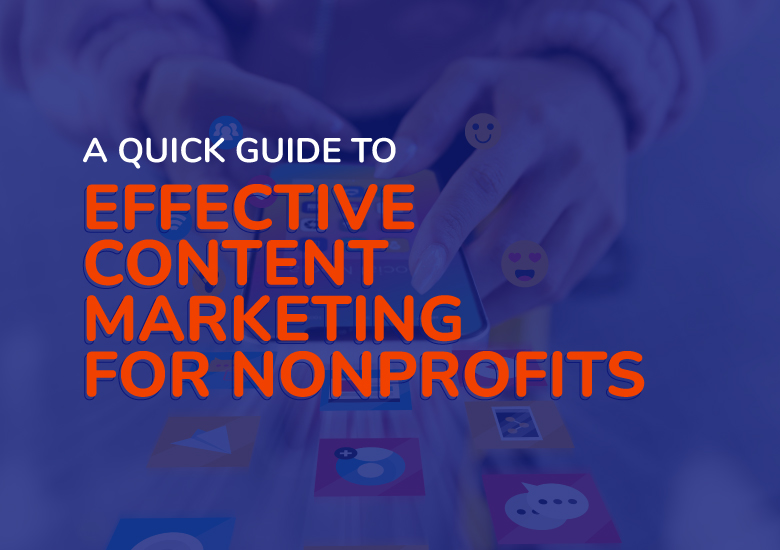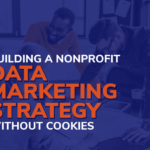A Quick Guide to Effective Content Marketing for Nonprofits

Every nonprofit knows that marketing is essential for increasing visibility, encouraging donations and involvement from supporters, and building strong community relationships. However, it takes time to master all the different types of outreach that go into an effective multichannel strategy. From posting on social media and sending email newsletters to creating Google Ads, a multichannel strategy can help you reach more supporters than ever before.
One type of marketing that is especially important to learn about and leverage is content marketing. Creating useful, informative, or entertaining content related to your cause can go a long way toward helping you share your organization’s story and establishing you as a thought leader for your cause.
In this post, we’ll explore what content marketing is and how you can create a winning content strategy. Let’s begin!
What is Content Marketing?
Content marketing is an inbound marketing strategy that involves creating and sharing valuable and relevant content that attracts, engages, and inspires your target audience. A strategy that encourages your audience members to organically convert over time to support your mission is essential for nonprofit organizations.
Here’s how it works: Instead of promoting your organization’s cause, campaigns, or events outright, content marketing focuses on offering useful, informative, and compelling content that educates or entertains. As a result, you build trust-based relationships with your audience that eventually lead them to take action for your nonprofit.
How Content Marketing Helps Nonprofits
There are several benefits to engaging your audience through content marketing. These include:
- Increased awareness of your mission and impact: To engage your audience in your work, they need to understand what you do and why it matters. Content marketing allows you to check both of these boxes by providing educational information about the issues you’re working to solve, leaning into the power of storytelling, and highlighting the long-term outcomes and successes your organization and its community have created for those you serve.
- More organic touchpoints with your supporters: Too many donation appeals, event invitations, or volunteer opportunity promotions can result in supporter fatigue. Content marketing offers you the opportunity to stay in touch with your supporters while engaging them in a more organic way that doesn’t require them to commit to action right away. This type of communication can be refreshing for your supporters and result in them being excited to take action again soon.
- Expanded reach: Content that doesn’t request or demand immediate action is inherently more accessible for people new to your cause. It’s also more shareable for people familiar with your work. When you create content that is engaging in its educational or entertainment value, you’ll have a much easier time expanding your organization’s reach to new supporters who are just learning about your work for the first time.
- Cost-effectiveness: Content marketing is often more affordable compared to other channels, such as traditional advertising. In fact, content marketing generates three times more leads than traditional advertising while costing 62% less. Popular types of content, such as social media posts, email campaigns, and blog posts, are relatively inexpensive to create and allow you to reach a broader audience.
- Enhanced credibility and trust: To stand out from the millions of nonprofits around the world, your organization needs to establish itself as a credible source of information for all things related to its cause. Content marketing allows you to share your thought leadership, boosting your credibility and encouraging your community to trust you.
While content marketing inherently discourages you from issuing obvious calls to action to your audience, it also has the benefit of laying the groundwork for your supporters to take action. It encourages you to educate your audience and build relationships with them before you ask supporters to do something for you.
Types of Content That Work Well for Nonprofits
So, what types of content should you produce to experience the benefits listed above? Here are a few popular options that tend to work well for nonprofits:
- Website content: Your organization’s website is a powerful content marketing tool. Here, you can share educational information about your cause and the history of your organization, as well as up-to-date impact information. In particular, your blog will be valuable for creating and publishing engaging, shareable content on a consistent basis.
- Social media posts: Social media allows you to share short text-based content alongside eye-catching visual elements, like photos, graphics, or videos. This type of content is inherently digestible and easy for others to engage with and share. You can increase your posts’ reach by enlisting ambassadors to share them with their networks.
- Email newsletters: Emails allow you the room to create more long-form content and link out to additional resources on your website or social media profiles. Plus, when you take the time to write engaging subject lines and ensure your emails are branded to your organization, you’ll leave a lasting positive impression on your recipients.
- Infographics: Infographics empower you to share information like impact data in visually engaging and digestible ways. They can help provide a birds-eye view of why and how your organization’s work matters to those you serve. They’re also easy for your audience to share with others.
- Videos: Videos are easy for your community to engage with, especially when they’re short and reliant on emotionally evocative imagery and music. Consider creating videos to share on your website or social media. If your brand voice allows, you might even leverage current video trends on popular platforms like Instagram.
Ultimately, the types of content you decide to create will come down to understanding your audience and what engages them. Rely on your marketing data to discover what type of messages and channels typically resonate with your supporters, and focus your content marketing efforts there.
How to Create a Winning Content Strategy
If you’re ready to weave content marketing into your outreach strategy, you’ll need to take the time to design a careful approach that sets you up to see great results. Here are some tips for doing so:
- Know your audience. Ensure that your content is set up to engage your specific audience by reviewing what you know about them. Turn to your organization’s data sources, such as your constituent relationship marketing system (CRM) or marketing platforms, to identify patterns and trends in communication channels, frequency, and messaging that best resonate with your supporters. You can use this information to divide your audience into groups to more easily tailor your content to their needs. For instance, younger members of your community may respond better to short-form videos shared on social media, while older individuals may appreciate longer blog content.
- Create a content calendar. Successful content marketing requires consistency. A content calendar will help you map out the types of content you want to create, plan out the process of designing or writing that content, and schedule when it needs to go live. Align your content calendar with your organization’s campaign and events calendar to ensure all your communications work together to engage your supporters rather than overwhelm them.
- Focus on maintaining a strong brand voice. When you think of nonprofit branding, you probably think of logos and color schemes. However, there are intangible elements that go into it as well, such as your brand voice, or how you talk to your audience about your cause and your organization. Developing and maintaining a distinct, consistent brand voice will help you establish yourself as a thought leader in your niche. Consider developing a brand book with language guidance to ensure brand voice consistency across all marketing materials.
- Repurpose content across several channels. One of the beauties of content marketing is that it is relatively inexpensive, partially because you can easily repurpose content across different channels. For example, you can transform blog post content into a few different emails or social media posts. Once you’ve created a rich source of information, take full advantage of it by using it in various ways to engage audience members where they are.
- Measure your progress toward marketing objectives. Your organization likely already has several marketing goals it’s pursuing. Measure how your content marketing assets contribute to your ability to reach those objectives. Identify relevant metrics you’ll track and measure over time, such as web page session length or email click-through rate.
As you develop your own content marketing strategy, remember that every new marketing approach your organization adopts will require a bit of trial and error to get right. Monitor your progress toward your goals and pay attention to how your audience responds to your content. Then, you can make informed decisions about how to improve your content over time.
Content marketing is an excellent way to engage your nonprofit’s audience without expecting any action from them right off the bat. It allows you to educate your supporters and build relationships with them rooted in trust and credibility, which in turn will inspire them to take action for your cause. Use this quick guide to get started with your own content marketing strategy.


